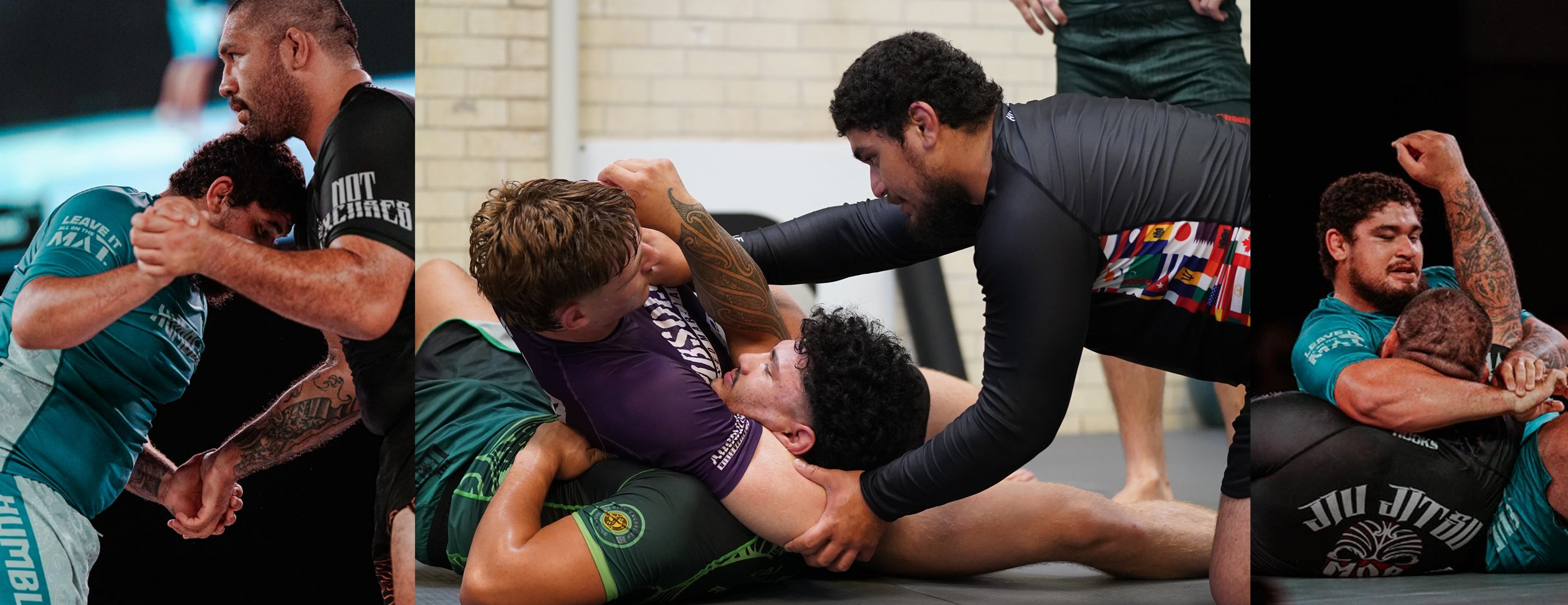Article: The Complete BJJ Belt System Guide

The Complete BJJ Belt System Guide
Brazilian Jiu-Jitsu is one of the toughest yet most rewarding martial arts. It's also incredibly popular, with practitioners in almost every country throughout the globe. But if you're just getting started, the belt order and progression can get a little complicated.
This guide will cover jiu-jitsu belt order, the jiu-jitsu belt system and anything else you might need to know about BJJ belts, including how to tie jiu-jitsu belts and where to get them.
Brazilian Jiu-Jitsu Belt Order
The belt order in jiu-jitsu is similar to other martial arts, but it does have its own quirks to be aware of. Each colour signifies the time put into practice and skill level, ranging from white belt to black belt and even coral belt.
Unlike other martial arts, Brazilian Jiu-Jitsu is very conservative in how it awards belts. Most belts will require you to spend years honing your skills before you're eligible to progress to the next belt. While it might seem restrictive, this is done to uphold integrity and ensure practitioners are 100% ready to progress once the time comes.
White Belt
Unless you're a master in a similar martial art, the first belt anyone starts with is the white belt. Training with a white belt means you'll be forming a solid foundation, learning basic offensive moves like submissions and guard passes, escapes and defensive positioning, basic strategy and similar.
You'll want to spend your time as a white belt building good habits. This might be learning how to hold your guard properly, or simply how to keep yourself calm and your ego in check during sparring sessions.
Unless you started BJJ when you were very young (more on this later), you'll spend a year as a white belt before moving on to blue.
Blue Belt
Blue belt is the start of the adult levels in Brazilian jiu jitsu, where practitioners are required to be at least 16 years of age. It's here that most BJJ practitioners will learn the techniques they need to compete.
You'll learn a huge number of BJJ techniques and hone them over the course of the next year or more through hundreds of hours of mat time. You should be able to competently put someone into a submission and be able to escape from all major positions.
Blue belt level will be your first official opportunity to put the foundation you've been laying into practice. Your instructor will help you refine your skills here and train you to implement those skills efficiently in practice and in competition.
Purple Belt
The purple belt is a significant achievement in Brazilian Jiu-Jitsu (BJJ) and marks a major milestone in a practitioner's journey in the sport. A purple belt is considered an advanced practitioner who has a deep understanding of the techniques and principles of BJJ.
To achieve the purple belt, a practitioner must have gained a large amount of knowledge and mastered a range of techniques. They should also be able to demonstrate their proficiency in live sparring.
The time to reach a purple belt can vary depending on the individual and the academy. But typically, it can take a dedicated practitioner anywhere between 3 to 5 years of consistent training to achieve a purple belt. You must have spent 3 years as a blue belt to even be considered for a purple belt.
Brown Belt
After 3 years, practitioners are eligible to move to a brown belt. The brown belt is the highest-ranking "coloured" belt and requires a huge breadth of knowledge and skill to achieve. Most practitioners only achieve the brown belt after 6 years of dedicated training. You'll also have spent 2 years as a purple belt.
As a brown belt, you'll spend your time honing your techniques and improving your skills, aiming to become a master of your craft.
Black Belt
The black belt is technically the highest achievable belt in BJJ, as from here you're simply adding degrees to your black belt as you gain experience. At this point, practitioners have thousands of hours of experience and are considered experts in both technical and practical skills.
As a black belt, you will be participating in competitions and may even be instructing lower-ranked students yourself. Black belts are eligible to promote students to the rank of purple belt.
While you only have to spend a year as a brown belt to be eligible for a black belt, actually achieving the black belt is a monumental task. Additionally, you may only be promoted to a black belt by a practitioner with a first-degree black belt.
As you gain experience you'll achieve additional degrees on your black belt, usually being awarded one every three years up to the 9th degree.
Coral Belt (Red and Black)
The Coral belt is reserved for those who are true masters of BJJ, and famous for it. It's awarded instead of a 9th-degree black belt, and the earliest you can achieve it is at the age of 67.
While there is a 10th-degree black/red belt, this rank is reserved exclusively for the pioneers of Brazilian Jiu-Jitsu, and the Gracie brothers: Carlos, Oswaldo, George, Gaston and Helio.
Children's Belts
For kids under 16 years old, there's a whole other set of belts that fall under the banner of “white belt”. These children's belts, or youth belts, range from basic white belt all the way through to green belt, where you'll stay until turning 16 years old. If you've proven your skill, you'll move up to a blue belt and the adult belt system.
Occasionally, in exceptional cases practitioners have moved up from the youth belt system straight to purple belt, but this is rare.
How to Tie Jiu-Jitsu Belt
Tying your Brazilian jiu-jitsu belt can be a bit tricky, but once you get the hang of it, it will become second nature. Here's a step-by-step guide to help you out.
- Start by holding the belt in front of you and, making sure to keep both ends equal length, wrap it around the back of your waist.
- Cross the two ends of the belt behind your waist and pull tight. Then bring both ends to the front.
- Now take the right side of the belt and bring it over the left side, tucking it under every layer of the belt from the bottom up.
- Finally, cross the top strand over the bottom strand, loop the bottom strand through the hole you've created and pull tight!
- You should now have a knot. Make sure that the belt is snug but not too tight, and adjust as needed.
And that's it! With a little practice, you'll be able to tie your jiu-jitsu belt in no time. Remember to keep your belt clean and in good condition, show respect to your training partners and instructors, and stay humble!

